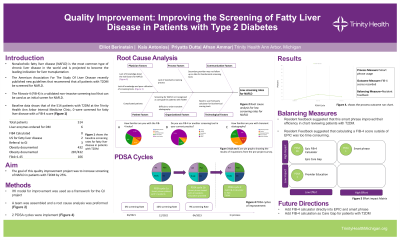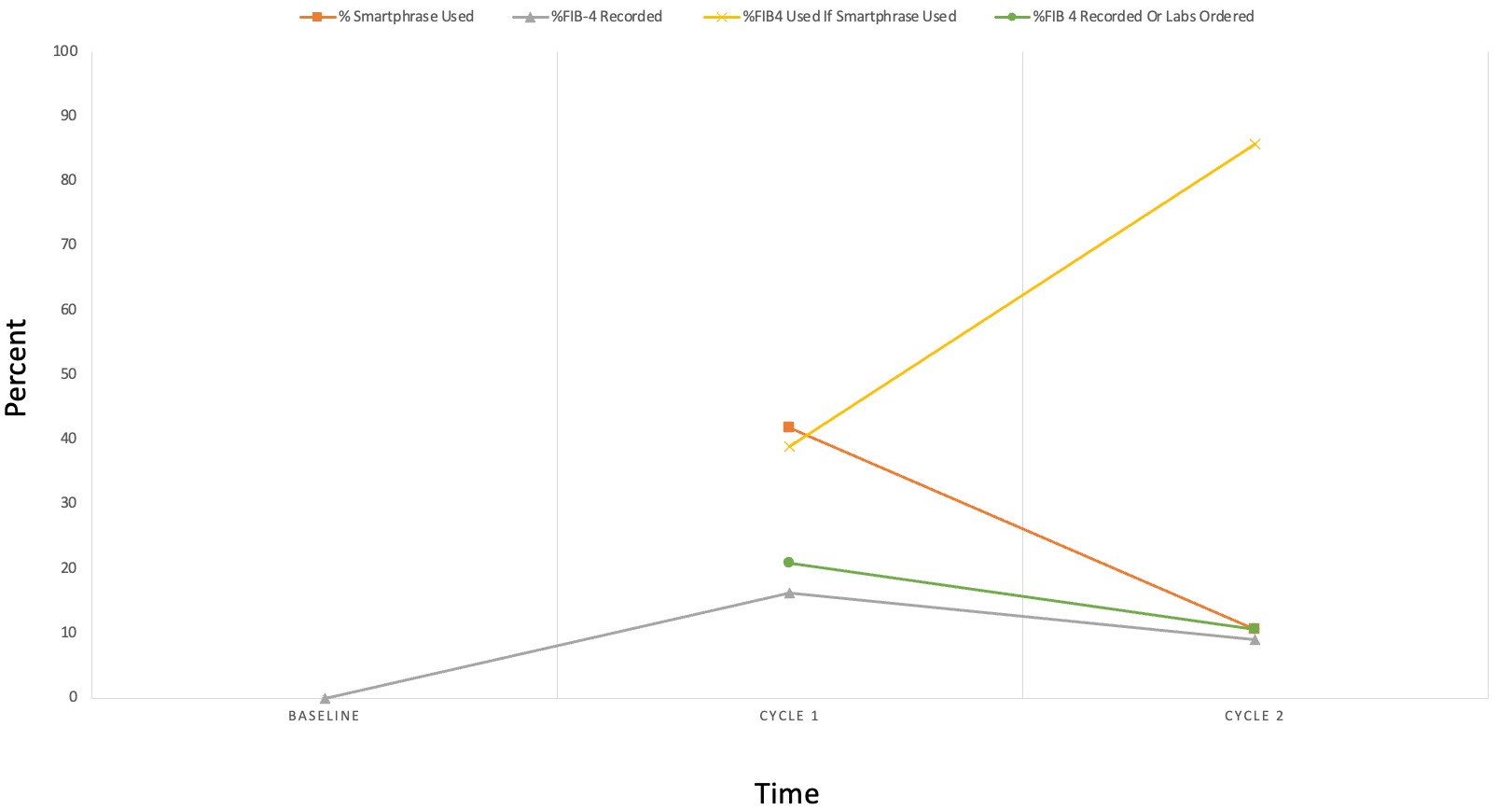Sunday Poster Session
Category: Liver
P0914 - Quality Improvement: Improving the Screening of Fatty Liver Disease in Patients with Type 2 Diabetes Mellitus
Sunday, October 22, 2023
3:30 PM - 7:00 PM PT
Location: Exhibit Hall

Has Audio

Elliot Berinstein, MD, MSc
Trinity Health Ann Arbor
Ypsilanti, MI
Presenting Author(s)
Elliot Berinstein, MD, MSc, Kais Antonios, MD, Dutta Priyata, MD, Afnan Ammar, MD
Trinity Health Ann Arbor, Ypsilanti, MI
Introduction: Nonalcoholic fatty liver disease (NAFLD) is the most common type of chronic liver disease in the world and is projected to become the leading indication for liver transplantation. Studies have shown that in patients with type 2 diabetes mellitus (T2DM), liver steatosis, advanced fibrosis and cirrhosis were present in 73.8% 15.4% and 7.7% of patients, respectively. The American Association For The Study Of Liver Diseases recently published new guidelines that recommend that all patients with T2DM be screened for NAFLD. The Fibrosis-4 (FIB-4) is a validated non-invasive screening tool that can be used as an initial screen for NAFLD. We identified that T2DM patients were not being screened appropriately in our clinic. The goal of this quality improvement project was to increase the for NAFLD in patients with T2DM by creating a smartphrase and providing education to providers.
Methods: We reviewed the medical charts for 514 patients with T2DM seen in our Academic Internal Medicine (AIM) Clinic between 2020 and 2022 to assess baseline screening rates. A smartphrase was created through EPIC and included all relevant information to help providers assess for complications of T2DM including NAFLD. For cycle 1, starting in 12/2022, the smartphrase was piloted with 5 residents and their usage was recorded. For cycle 2, starting 04/2023, the smartphrase was shared with all residents and multiple educational sessions were held. Usage of the smartphrase, recording a FIB-4 score or collecting labs to do so were monitored.
Results: Results of a baseline assessment of 514 patients with T2DM showed that 0 % of patients were screened with a FIB-4 score. During cycle 1, the smartphrase was used in 41% of patient visits for T2DM (Fig 1). A FIB-4 score was recorded or labs were ordered to so in 20.9 % of patients(Fig 1). During cycle 2, the smartphrase was used in 10% of patient visits for T2DM and a FIB-4 score was recorded or labs were ordered 10.6% of the time(Fig 1). However, when the smartphrase was used, a FIB-4 score was recorded 85.7% of the time(Fig 1).
Discussion: It is important to identify individuals with NAFLD while it is in the early stages to prevent progression to cirrhosis and hepatocellular carcinoma. Implementing a smartphrase was shown to improve the screening rates for NAFLD. Further improvement can be made by automatically calculating a FIB-4 score and alerting providers if a FIB-4 score has not been documented in the past 2 years.

Disclosures:
Elliot Berinstein, MD, MSc, Kais Antonios, MD, Dutta Priyata, MD, Afnan Ammar, MD. P0914 - Quality Improvement: Improving the Screening of Fatty Liver Disease in Patients with Type 2 Diabetes Mellitus, ACG 2023 Annual Scientific Meeting Abstracts. Vancouver, BC, Canada: American College of Gastroenterology.
Trinity Health Ann Arbor, Ypsilanti, MI
Introduction: Nonalcoholic fatty liver disease (NAFLD) is the most common type of chronic liver disease in the world and is projected to become the leading indication for liver transplantation. Studies have shown that in patients with type 2 diabetes mellitus (T2DM), liver steatosis, advanced fibrosis and cirrhosis were present in 73.8% 15.4% and 7.7% of patients, respectively. The American Association For The Study Of Liver Diseases recently published new guidelines that recommend that all patients with T2DM be screened for NAFLD. The Fibrosis-4 (FIB-4) is a validated non-invasive screening tool that can be used as an initial screen for NAFLD. We identified that T2DM patients were not being screened appropriately in our clinic. The goal of this quality improvement project was to increase the for NAFLD in patients with T2DM by creating a smartphrase and providing education to providers.
Methods: We reviewed the medical charts for 514 patients with T2DM seen in our Academic Internal Medicine (AIM) Clinic between 2020 and 2022 to assess baseline screening rates. A smartphrase was created through EPIC and included all relevant information to help providers assess for complications of T2DM including NAFLD. For cycle 1, starting in 12/2022, the smartphrase was piloted with 5 residents and their usage was recorded. For cycle 2, starting 04/2023, the smartphrase was shared with all residents and multiple educational sessions were held. Usage of the smartphrase, recording a FIB-4 score or collecting labs to do so were monitored.
Results: Results of a baseline assessment of 514 patients with T2DM showed that 0 % of patients were screened with a FIB-4 score. During cycle 1, the smartphrase was used in 41% of patient visits for T2DM (Fig 1). A FIB-4 score was recorded or labs were ordered to so in 20.9 % of patients(Fig 1). During cycle 2, the smartphrase was used in 10% of patient visits for T2DM and a FIB-4 score was recorded or labs were ordered 10.6% of the time(Fig 1). However, when the smartphrase was used, a FIB-4 score was recorded 85.7% of the time(Fig 1).
Discussion: It is important to identify individuals with NAFLD while it is in the early stages to prevent progression to cirrhosis and hepatocellular carcinoma. Implementing a smartphrase was shown to improve the screening rates for NAFLD. Further improvement can be made by automatically calculating a FIB-4 score and alerting providers if a FIB-4 score has not been documented in the past 2 years.

Figure: Figure 1. Shows the percentage of time that the smartphrase was used, the percentage of time the FIB-4 score was recorded or labs were ordered, the percentage of time a FIB-4 score was recorded in all patients seen for T2DM and the percentage of time a FIB-4 score recorded when the smartphrase was used.
Disclosures:
Elliot Berinstein indicated no relevant financial relationships.
Kais Antonios indicated no relevant financial relationships.
Dutta Priyata indicated no relevant financial relationships.
Afnan Ammar indicated no relevant financial relationships.
Elliot Berinstein, MD, MSc, Kais Antonios, MD, Dutta Priyata, MD, Afnan Ammar, MD. P0914 - Quality Improvement: Improving the Screening of Fatty Liver Disease in Patients with Type 2 Diabetes Mellitus, ACG 2023 Annual Scientific Meeting Abstracts. Vancouver, BC, Canada: American College of Gastroenterology.
